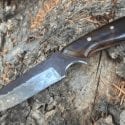There are two reasons to buy a high quality (read: expensive) knife: one is that you’ve reached that point in life when your bank account doesn’t empty every month; the second can be summed up in a passage from Terry Pratchet’s Men at Arms: the Play:
The reason that the rich were so rich, Vimes reasoned, was because they managed to spend less money.
Take boots, for example. He earned thirty-eight dollars a month plus allowances. A really good pair of leather boots cost fifty dollars. But an affordable pair of boots, which were sort of OK for a season or two and then leaked like hell when the cardboard gave out, cost about ten dollars. Those were the kind of boots Vimes always bought and wore until the soles were so thin that he could tell where he was in Ankh-Morpork on a foggy night by the feel of the cobbles.
But the thing was that good boots lasted for years and years. A man who could afford fifty dollars had a pair of boots that’d still be keeping his feet dry in ten years’ time, while the poor man who could only afford cheap boots would have spent a hundred dollars on boots in the same time and would still have wet feet.
This was the Captain Samuel Vimes ‘Boots’ theory of socioeconomic unfairness.
Point is, you can go out and get yourself a neck knife from Amazon for a heck of a lot less than the $400+ that Murray Carter charges for a neck knife. But, if you’re interested in purchasing one knife that will accompany you for the span of your life and your children’s for the span of theirs, you don’t plug Amazon into your browser. You get one of these:
Who is Murray Carter?
Murray Carter is not just a bladesmith. There are plenty of those around. Rather, Murray is the 17th generation Yoshimoto bladesmith, carrying on a 420-year tradition of forging going back to feudal Japan and the Samurai tradition. And yes, Murray is as not-Japanese as his name sounds; he was born in Nova Scotia.
Murray apprenticed with Sensei Yasuyuki Sakemoto, the 16th generation Yoshimoto bladesmith, for six years in Japan before working as a village bladesmith for twelve years. He continues to visit his Sensei in Japan, keeping his Japanese language skills fresh and sourcing all of his materials from the country. So far, he has forged over 30,000 individual blades.
Murray has Western credentials, too. He’s been rated a Master Smith by the American Bladesmith Societysince 2001. When he moved to Hillsboro, Oregon, in 2005, he immigrated as an Alien of Extraordinary Ability. That means that even the US government – a font of wisdom in the best of times – saw fit to recognize Murray’s exceptional skill. He’s been featured in Tim Ferriss’s podcast.
Forging a Carter Neck Knife
Where most commercial knives are stamped and ground, Murray begins each neck knife with two types of steel. The core is Hitachi White #1 which is laminated with 410 steel. Hitachi White #1 is a high-carbon steel with low impurities that sharpens easily but holds an edge well. Known as Shirogami, White steel’s exceptional qualities come with some disadvantages. A bladesmith must bring the metal into a very narrow temperature range before quenching; exceptional skill is required.
410 steel, on the other hand, is a stainless alloy with high corrosion and wear resistance. It’s a more resilient steel than White. Folding the two together, with White in the middle and 410 on the outside, results in a blade that holds a sharp edge of carbon steel but doesn’t corrode as readily. It’s the best of both worlds.
Each Carter neck knife is hand forged. Murray leaves a hammered finish on the outside to honor the forging process. Each blade is forged with a distal taper, meaning the tip of the blade is thinner than the middle. While plenty of knives have a distal taper, most manufacturers grind the taper instead of forging it. Why is forging it better? The forging process results in more consistent, better aligned grains in the metal. Better grain means a stronger blade that holds an edge longer, but is easier to sharpen when it needs love.
Each Carter knife – designated by the “Carter” signature stamped on the blade – is hand-forged to within 95% of its final shape and heat treated in a pine charcoal fire.
It looks like Murray uses a flat grind on each neck knife. Ours certainly does. The edge is then honed to an exceptionally sharp edge – it effortlessly shaves arm hair out of the box. Carter neck knives receive a beautifully shaped handle made of G10, carbon fiber, micarta, or stabilized, exotic wood. They include contrasting, G10 liners, silver-nickel pins with a mosaic center pin, and are, quite simply, gorgeous. Murray’s knives are beautiful both for their form and function.
Carter Neck Knife Review
Would you be concerned about using a $425 knife daily? For tough jobs? Yeah, me too. But, Murray gave me carte blanche with the knife. He said we could beat it up and that he would recondition it upon its return. So, with that concern eliminated, I went to town.
Carter’s edges are frighteningly legendary. Yes, the blade slices right through paper. But it continued to slice through paper easily even after extensive beatings. Between paper slicing, I cut into softwood branches, vegetables, corrugated boxes, and other various, sundry materials.
In addition to the stellar blade, metallurgy, and edge, I’m absolutely in love with Murray’s scales. Impeccably shaped, the scales don’t cover the entire tang of the knife. Rather, there is an exposed finger choil for the index finger. Between the perfectly shaped scales and the choil, the knife is exceptionally easy to control.
One of the more important aspects of a fixed-blade knife, after edge and handle, is carry. Carter neck knives are available with custom-shaped kydex sheaths. The sheath is as small is it can be – just big enough to hold the blade with room for rivets. Ours held the neck knife tightly, but allowed easy withdrawal and sheathing of the knife. The sheath hangs from a 550-cord lanyard, which is adjustable.
After using the knife for a few months, I’ve learned that I needn’t have worried about beating up Murray’s blade. It shows not a single sign of wear.
Final Thoughts
I like to suggest areas where manufacturers can improve their gear. I’ve been accused of being too damn opinionated. Please believe me when I tell you that I tried very hard to look for a single angle from where I could offer critique of Murray’s knives. It simply is not there. Carter neck knives are EDC cutlery perfection.
Carter neck knives are available only from Murray’s website. Prices range from $410-505, depending on length and handle material. If that’s too steep for you, Carter Muteki neck knives, forged by graduates of Murray’s apprenticeship program and under his direct supervision, start at $250.






Leave a Reply